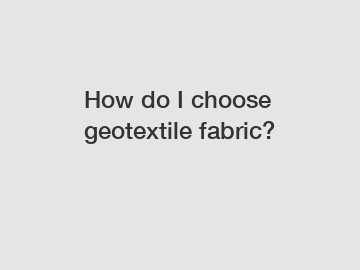Dec. 29, 2023
Construction
When it comes to construction and civil engineering projects, choosing the right geotextile fabric is crucial. Geotextiles serve as the backbone in various applications, providing strength, stability, and durability to the project. However, with a plethora of options available in the market, selecting the ideal geotextile fabric can be overwhelming. In this blog, we will guide you through the process of choosing the perfect geotextile fabric by considering several important factors. Our aim is to ensure you make an informed decision that meets your project's requirements and delivers long-lasting results.
1. Determine the Project Requirements:
The first step in selecting the right geotextile fabric is to understand the specific needs of your project. Consider the soil conditions, load-bearing requirements, and environmental factors such as drainage, erosion control, or reinforcement. Consulting with a geotechnical engineer or an experienced professional can help you accurately assess the project's requirements and determine the appropriate geotextile properties.

2. Geotextile Material:
Geotextile fabrics are available in various materials, each offering unique properties and advantages. The three primary types are woven, non-woven, and composite geotextiles. Woven geotextiles are made by weaving individual threads together, creating a strong and durable fabric. Non-woven geotextiles, on the other hand, are manufactured by bonding fibers together, offering excellent filtration and drainage capabilities. Composite geotextiles integrate the best properties of both woven and non-woven materials. Consider the specific application requirements and consult with experts to determine the most suitable material for your project.
3. Geotextile Durability:
Durability is a crucial factor when selecting geotextile fabric since it directly affects the lifespan and overall performance of the project. Factors such as tensile strength, puncture resistance, and UV stability should be considered. Higher tensile strength ensures the geotextile can withstand the load and stress exerted by the project. Puncture resistance is crucial for areas prone to sharp objects or potential damage. The UV stability of the fabric is essential if your project will be exposed to sunlight for an extended period. By assessing these durability aspects, you can ensure the longevity of your geotextile investment.
4. Appropriate Permeability:
Further reading:Permeability is a critical consideration for geotextile selection, particularly in applications involving drainage, filtration, or erosion control. The geotextile should allow water to pass through while retaining particles and preventing clogging. Understanding the required permeability characteristics of your project will help you select the correct geotextile, ensuring effective water flow and adequate filtration.
5. Compatibility with Soil:
Compatibility between the geotextile fabric and the soil or aggregate is vital for maintaining the intended function and performance. Consider factors such as soil type, gradation, and pH levels to ensure proper interaction between the geotextile and the soil. Compatibility testing, carried out by geotechnical professionals, can provide valuable insights into the behavior of geotextiles in your specific soil conditions.
6. Environmental Considerations:
Environmental factors play a significant role in geotextile selection, especially where erosion control or environmental protection is needed. Look for geotextile fabrics that are manufactured using eco-friendly materials and consider their ability to resist chemical degradation or biological attack. Additionally, select geotextiles that are easy to install and do not harm the surrounding ecosystem.
Conclusion:
Choosing the right geotextile fabric is a critical decision that can significantly impact the success and durability of your construction or civil engineering project. By considering factors such as project requirements, geotextile material, durability, permeability, soil compatibility, and environmental concerns, you can make an educated choice. Remember, consulting with industry experts and geotechnical engineers helps to ensure the selected geotextile fabric meets your project's unique needs. With the right geotextile fabric in place, you can lay a strong foundation and build with confidence.
Disclaimer: The information provided here is for general guidance purposes only and should not be considered professional advice. Always consult with a geotechnical engineer or qualified professional for specific project recommendations.
If you are looking for more details, kindly visit geosynthetic clay liner supplier, geotextile membrane, concrete protective liners.
Further reading:Previous: Which Innovative Applications are Revolutionizing Denmark's Aluminium Coil Industry?
Next: Indulge in Opulence: Exquisite Luxury Bathroom Shower Sets
Related Articles
If you are interested in sending in a Guest Blogger Submission,welcome to write for us!
All Comments ( 0 )